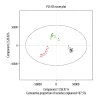Lipid Biomarkers in Acute Myocardial Infarction Before and After Percutaneous Coronary Intervention by Lipidomics Analysis
- PMID: 29913478
- PMCID: PMC6038721
- DOI: 10.12659/MSM.908732
Lipid Biomarkers in Acute Myocardial Infarction Before and After Percutaneous Coronary Intervention by Lipidomics Analysis
Abstract
BACKGROUND Reperfusion injury is one of the leading causes of myocardial cell death and heart failure. This study was performed to identify new candidate lipid biomarkers for the purpose of optimizing the diagnosis of myocardial ischemia reperfusion (I/R) injury, assessing the severity of myocardial I/R injury and trying to find the novel mechanism related to lipids. MATERIAL AND METHODS Forty patients who were diagnosed with ST-segment elevation myocardial infarction (STEMI) were randomly selected for this study. Serum samples from all the patients with STEMI were collected at 3 time periods: after STEMI diagnosis but prior to reperfusion (T0); and then at 2 hours (T2) and 24 hours (T24) after the end of the percutaneous coronary intervention procedure. Plasma lipidomics profiling analysis was performed to identify the lipid metabolic signatures of myocardial I/R injury using lipidomics. RESULTS Sixteen types of potential lipid biomarkers at different time periods (T0, T2, T24) were identified by using lipidomics technology. The T0 time periods exhibited 16 differentially metabolized lipid peaks in the patients after STEMI diagnosis but prior to reperfusion. With the increase of reperfusion times, the contents of these 16 lipid biomarkers decreased gradually, but there was a 1.5- to 2-fold increase of those 16 lipid biomarkers contents at T2 compared with T24. CONCLUSIONS Lipidomics analysis demonstrated differential change before and after reperfusion, suggesting a potential role of some of these lipids as biomarkers for optimizing the diagnosis of myocardial I/R, as well as for therapeutic targets against myocardial I/R injury.
Conflict of interest statement
None.
Figures




Similar articles
-
Circulating HtrA2 as a novel biomarker for mitochondrial induced cardiomyocyte apoptosis and ischemia-reperfusion injury in ST-segment elevation myocardial infarction.Int J Cardiol. 2017 Sep 15;243:485-491. doi: 10.1016/j.ijcard.2017.05.088. Epub 2017 May 24. Int J Cardiol. 2017. PMID: 28602551
-
Apoptosis kinetics at reperfusion period in patients with acute ST-Segment Elevation Myocardial Infarction undergoing primary percutaneous coronary intervention and treated with thrombolytic therapy.J Pak Med Assoc. 2016 Jul;66(7):808-14. J Pak Med Assoc. 2016. PMID: 27427127
-
B-type natriuretic peptide as a predictor of ischemia/reperfusion injury immediately after myocardial reperfusion in patients with ST-segment elevation acute myocardial infarction.Eur Heart J Acute Cardiovasc Care. 2016 Feb;5(1):62-70. doi: 10.1177/2048872615568964. Epub 2015 Jan 21. Eur Heart J Acute Cardiovasc Care. 2016. PMID: 25609593
-
Reperfusion in STEMI patients: still a role for cardioprotection?Minerva Cardioangiol. 2018 Aug;66(4):452-463. doi: 10.23736/S0026-4725.18.04680-7. Epub 2018 Mar 28. Minerva Cardioangiol. 2018. PMID: 29589674 Review.
-
The pathophysiology of acute myocardial infarction and strategies of protection beyond reperfusion: a continual challenge.Eur Heart J. 2017 Mar 14;38(11):774-784. doi: 10.1093/eurheartj/ehw224. Eur Heart J. 2017. PMID: 27354052 Review.
Cited by
-
Cardiac phospholipidome is altered during ischemia and reperfusion in an ex vivo rat model.Biochem Biophys Rep. 2021 Jun 10;27:101037. doi: 10.1016/j.bbrep.2021.101037. eCollection 2021 Sep. Biochem Biophys Rep. 2021. PMID: 34169155 Free PMC article.
-
Identification of lipid metabolism-related genes in myocardial infarction: implications for diagnosis and therapy.J Cardiothorac Surg. 2025 Jul 9;20(1):289. doi: 10.1186/s13019-025-03525-4. J Cardiothorac Surg. 2025. PMID: 40635026 Free PMC article.
-
Defining Acute Coronary Syndrome through Metabolomics.Metabolites. 2021 Oct 6;11(10):685. doi: 10.3390/metabo11100685. Metabolites. 2021. PMID: 34677400 Free PMC article. Review.
-
Lipidomics Provides New Insight into Pathogenesis and Therapeutic Targets of the Ischemia-Reperfusion Injury.Int J Mol Sci. 2021 Mar 10;22(6):2798. doi: 10.3390/ijms22062798. Int J Mol Sci. 2021. PMID: 33801983 Free PMC article. Review.
-
Notoginsenoside R1 Regulates Ischemic Myocardial Lipid Metabolism by Activating the AKT/mTOR Signaling Pathway.Front Pharmacol. 2022 Jun 22;13:905092. doi: 10.3389/fphar.2022.905092. eCollection 2022. Front Pharmacol. 2022. PMID: 35814216 Free PMC article.
References
-
- Bhayana V, Henderson AR. Biochemical markers of myocardial damage. Clin Biochem. 1995;28:1–29. - PubMed
-
- Le Mar HJ, West SG, Garrett CR, et al. Covert hypothyroidism presenting as a cardiovascular event. Am J Med. 1991;91:549–52. - PubMed
-
- Cohen LF, Mohabeer AJ, Keffer JH, et al. Troponin I in hypothyroidism. Clin Chem. 1996;42:1494–95. - PubMed
MeSH terms
Substances
LinkOut - more resources
Full Text Sources
Other Literature Sources
Medical

